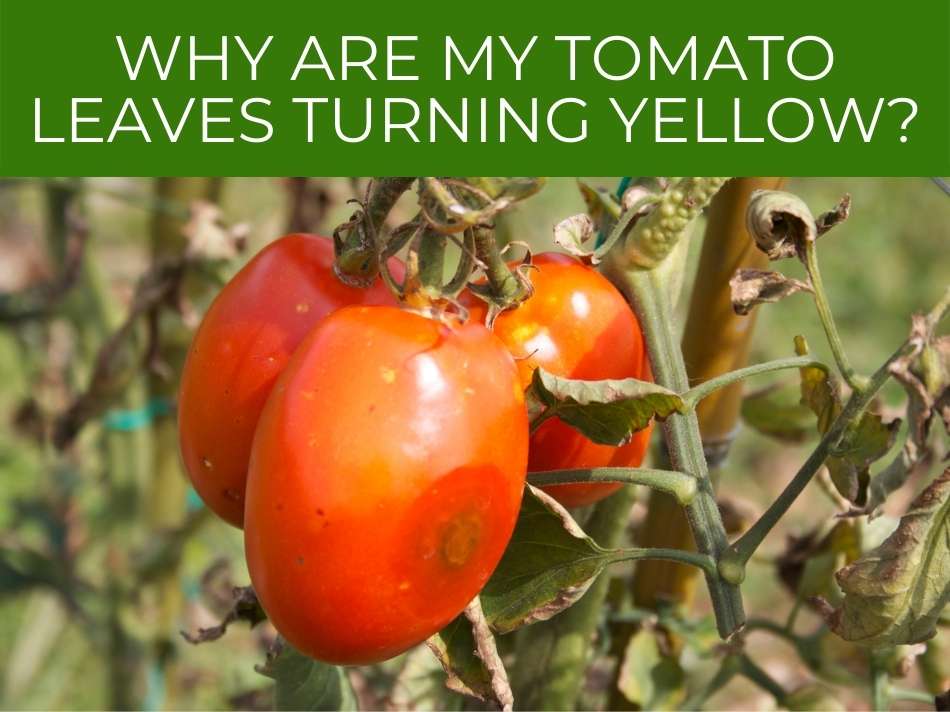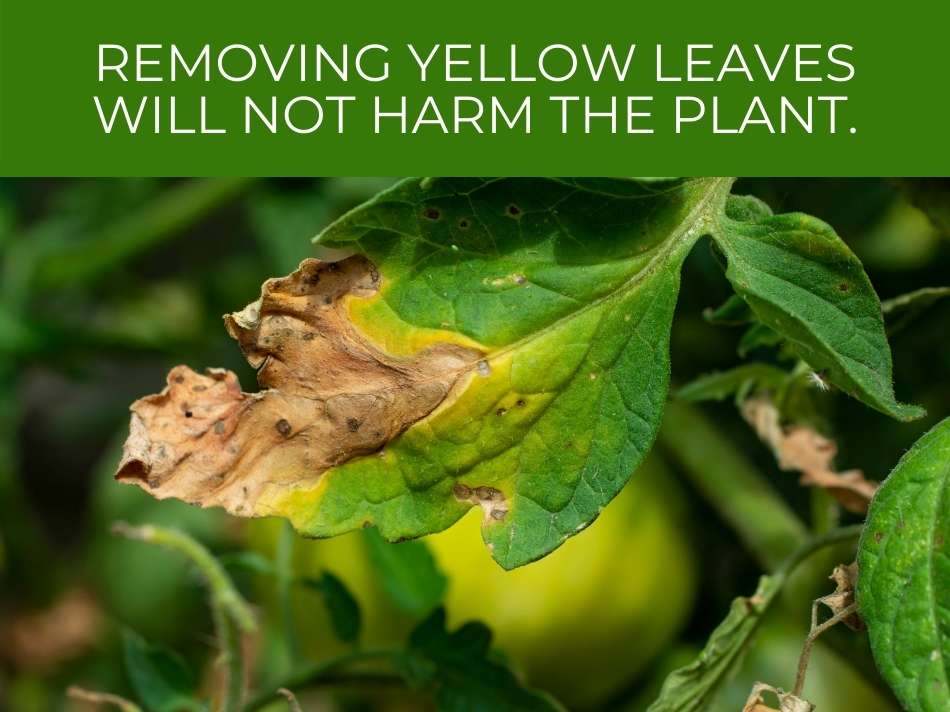We all love to see our plants looking healthy and then producing a lot of fruit or vegetables once they reach maturity. Plants struggle at times, however, and you can tell a lot about the health of a plant by its leaves.
Tomato leaves most commonly turn yellow due to overwatering and/or nitrogen deficiency. Yellow leaves usually indicate insufficient nutrients or too much water–which can leach away nutrients from soil. Also, if soil pH is outside the ideal range of 6.0-6.8, nutrients are less available.
There can be several reasons, just as there are reasons why leaves curl up on some tomato plants. Many plants can tell us a lot about their health and what they need by how their leaves are doing.

Tomato plant leaves turning yellow
Tomato plants grow well and produce a lot when they are healthy.
The plants are sensitive and needy though, and they can become stressed easily.
When leaves turn yellow, or if they start to curl, the plant feels stressed about something.
Leaves usually turn yellow because the plant is overwatered or has a nitrogen deficiency, though there can be other causes.. The plant goes into defensive mode and withholds water and nutrients from its leaves. This results in yellowing or droopy leaves.
Tomato plants need a lot of nutrients.
They will need a lot of fertilizing as they take a lot from the soil as they grow.
Paying close attention to the leaves can help you monitor the health of your plants as they grow.
Find out what soil type is best for tomatoes.

Why are my tomato leaves turning yellow?
Leaves on tomato plants turn yellow when the plant is not getting the nutrients it needs such as nitrogen.
Roots take in water and nutrients from the soil and that can be blocked by a variety of things.
Too much water can rot roots, just like too little can dry them up, making them not function well.
A nitrogen deficit is a common reason tomato plant leaves turn yellow. However, other nutrient deficiencies may also be the cause. To make sure, do a soil test to see what is lacking. The pH level between 6 and 6.8 is ideal for tomatoes, & optimizes soil nutrients availability.
When there is not enough nitrogen, entire leaves will turn yellow at the bottom of the plant.
A lack of potassium makes the outer edges turn yellow and eventually brown.
Yellow leaves with green veins are a sign of a lack of magnesium.

Why are my tomato leaves turning yellow and curling?
Tomato plants can get stressed easily when something is amiss.
Often you can tell if your plants are stressed by looking at the leaves.
Curling or turning yellow are two basic things that happen when there is something affecting the health of the plant.
There are lots of reasons leaves may curl. The weather, herbicides, & viruses, are just a few of the causes. When they turn yellow it is usually a sign the plant is not getting the nutrients it needs (especially nitrogen).Dry, curling leaves might indicate insufficient water.
Too much or too little water, too much or too little sun, too hot or too cold, can all affect your plants, causing the leaves to curl or turn yellow.
To find out the specific reason, you will have to do some investigating, and maybe a soil test.

Tomato seedlings turning yellow
Tomato plants are sensitive, and seedlings are even more so.
When seedlings turn yellow it means the plant is not getting enough nutrients, and usually, that nutrient missing is nitrogen.
Before you rush out and get nitrogen fertilizer, realize there can be other causes and those should also be investigated.
The most common cause of tomato seedlings turning yellow is overwatering. Water can flood the roots and will either dilute or leach away nutrients–especially nitrogen. In this case, more fertilizer will not help because it will continue to get washed away.
Also keep in mind that as the plant grows, the leaves that came first will die off.
They may turn yellow and they can be cut off or left to fall off on their own.
When they continue to turn yellow it can be a sign of a greater issue.
Find out the most common causes (& fixes for) tomato seedlings not growing.

How to fix tomato plant yellow leaves?
Sometimes the simplest solution is best.
If the leaves on your plants are turning yellow, adjust the watering schedule.
Cut back on watering and see if that solves the issue.
If not, you will need to take more steps.
Plant tomato seedlings as soon as possible & make sure the soil is well fertilized, with a pH of 6-6.8. Leaving tomato plants in small pots too long can cause stress. The key for healthy plants is good soil and proper watering: soil should be damp but not soggy.
It is not the water that causes the leaves to turn yellow, but it could still be the culprit.
The reason they turn yellow is often because of a lack of nitrogen or some other nutrient.
Too much water can wash those nutrients away.

How do you fix yellow leaves on tomato plants?
You can cut yellow leaves off without harming the plant, and to some extent that will fix the problem.
Avoid cutting off the cotyledon leaves, which are the first two leaves on a seedling.
They will eventually dry up and fall off on their own.
Other leaves can be cut off without any problem.
Fixing yellow leaves is a matter of finding out what the source of the issue is. Decrease watering, and perform a soil test to determine if lack of nutrients (especially nitrogen) may be causing yellow leaves. Nutrients are important and often there is a deficiency in the soil.
Solving the yellow leaf issue is easier than solving the curling leaf issue.
The yellow leaf problem could, however, damage your plant more in the long run.
Fixing the yellow leaves will give your plant the nutrients it needs.

Should I remove yellow leaves from the tomato plants?
Other than the cotyledon leaves, the first two the plant produces, it is fine to cut off the yellow leaves.
Often, that is all you will have to do to keep your plant at its best.

Removing yellow leaves will not harm the plant. Cutting off lower yellow leaves may even be beneficial. Letting yellow leaves stay on the plant could cause them to attract fungus or insects which could further harm your plant.
The yellow leaves are there to show you the plant has an issue.
Cutting off the leaves will not harm the plant.
As you solve the issue by adjusting the water and nutrient levels, there will be fewer yellow leaves to contend with.
See our complete guide on whether to take yellow leaves off plants.

Overwatered tomato plant
We often worry about whether our plants are getting enough water, and often they are not.
Even so, it is possible to overwater a plant, which can cause just as many problems.
Overwatered tomato plants can cause root rot. Root rot happens when bacteria and fungus overwhelm the roots. When this happens, your plant will not be able to get the nutrients, or even water, that it needs to survive. So, reduce watering so that soil is moist but not soggy.
Sometimes, over-watered plants look like under-watered plants.
Yellow leaves usually signal over-watering.
You may also check the roots, which turn darker when they are overwatered.

Nitrogen deficiency in tomato plants
There should be plenty of nitrogen in the soil for your tomato plants.
If there is not enough nitrogen, the leaves will turn yellow and the plant will not do as well.
There can be different causes of nitrogen deficiency.
Nitrogen deficiency can be caused by overwatering, which leaches nitrogen from soil. First, adjust the watering, and if the yellowing continues, perform a soil test to confirm whether supplemental nitrogen is needed.
A lack of nitrogen will cause tomato leaves to turn yellow.
There can be other causes, but this is the main one.
A soil test is often the best solution, and then you can add nitrogen if that is the real issue.

